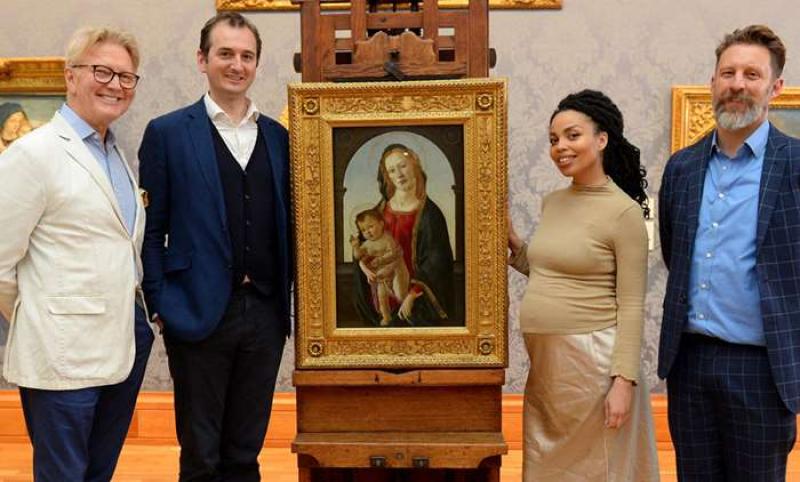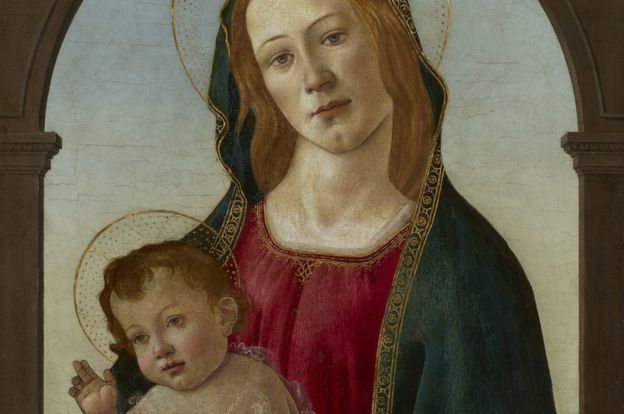Britain’s Lost Masterpieces, Episode Three, BBC Four review – more than a bit of Botticelli | reviews, news & interviews
Britain’s Lost Masterpieces, Episode Three, BBC Four review – more than a bit of Botticelli
Britain’s Lost Masterpieces, Episode Three, BBC Four review – more than a bit of Botticelli
A hidden Renaissance gem in Cardiff Art Gallery

Once again the whodunit becomes the whoforgedit in the newest installment of the Britain’s Lost Masterpieces series.
Social historian Emma Dabiri delves into the background of the work’s previous owner, the wealthy Gwendoline Davies, who bequeathed it to Cardiff Art Gallery in 1952. Davies believed the work to be an original Botticelli after their dealer had upgraded it from being merely “in the studio of Botticelli”. The Gallery downgraded the work following the gifting, but questions always lingered.
To try and fill gaps, Grosvenor takes us to Florence to understand the shady deception of the Medici era. After the Pope tried to sabotage Medici rule, the young Botticelli was sent to Rome to work on, amongst other projects, the Sistene Chapel. Upon returning to Florence after many years, Botticelli founded his own studio. It was here that the Madonna with Child would have been painted.
 Conservator Simon Gillespie is brought in to restore the painting. Along the way, he pries out details that widen the detective trail. Some of the cracks in the paint had been faked, suggesting a retouching by subsequent owners. This does not wholly discredit the work’s authenticity. Infrared and X-ray photographs confirm that some of the paint was applied in the style of Botticelli’s studio, and the poplar wood is the type that would have been used in Florence at the time.
Conservator Simon Gillespie is brought in to restore the painting. Along the way, he pries out details that widen the detective trail. Some of the cracks in the paint had been faked, suggesting a retouching by subsequent owners. This does not wholly discredit the work’s authenticity. Infrared and X-ray photographs confirm that some of the paint was applied in the style of Botticelli’s studio, and the poplar wood is the type that would have been used in Florence at the time.
This episode does well to introduce a touch of satire to the stupendous reverence. Grosvenor gushes endlessly over the beauty of the Madonna, only to have Dabiri accuse him of male voyeurism. Art dealers and connoisseurs – “sages” to some – are exposed as cunning status-hungry tricksters. One such, the American Bernard Berenson, would be heftily rewarded by his patron Joseph Duveen when a genuine original was found. This only incentivised Berenson to promote fakes as originals and to exaggerate their value. The Botticelli Madonna and Child came under his gaze. But Grosvenor sees this painting as an outlier for Berenson: “something about the quality of the face caught his eye”. Berenson may have been seduced, but he also genuinely believed the work to be a Botticelli studio production.
Back in Cardiff the work is finally presented. A letter is produced from the Yale University Art Gallery’s chief curator Laurence Kanter, a Botticelli expert: “Clearly this beautiful painting came from Botticelli’s studio. Probably Botticelli himself is responsible for more than a bit of it.” Not the glorious confirmation we might’ve wanted. But it seems just enough, at least for our host, who finally manages to tone down his enchantment: “We’re quite pleased with that”.
The future of Arts Journalism
You can stop theartsdesk.com closing!
We urgently need financing to survive. Our fundraising drive has thus far raised £49,000 but we need to reach £100,000 or we will be forced to close. Please contribute here: https://gofund.me/c3f6033d
And if you can forward this information to anyone who might assist, we’d be grateful.

Subscribe to theartsdesk.com
Thank you for continuing to read our work on theartsdesk.com. For unlimited access to every article in its entirety, including our archive of more than 15,000 pieces, we're asking for £5 per month or £40 per year. We feel it's a very good deal, and hope you do too.
To take a subscription now simply click here.
And if you're looking for that extra gift for a friend or family member, why not treat them to a theartsdesk.com gift subscription?
more TV
 theartsdesk Q&A: director Stefano Sollima on the relevance of true crime story 'The Monster of Florence'
The director of hit TV series 'Gomorrah' examines another dark dimension of Italian culture
theartsdesk Q&A: director Stefano Sollima on the relevance of true crime story 'The Monster of Florence'
The director of hit TV series 'Gomorrah' examines another dark dimension of Italian culture
 The Monster of Florence, Netflix review - dramatisation of notorious Italian serial killer mystery
Director Stefano Sollima's four-parter makes gruelling viewing
The Monster of Florence, Netflix review - dramatisation of notorious Italian serial killer mystery
Director Stefano Sollima's four-parter makes gruelling viewing
 The Diplomat, Season 3, Netflix review - Ambassador Kate Wyler becomes America's Second Lady
Soapy transatlantic political drama keeps the Special Relationship alive
The Diplomat, Season 3, Netflix review - Ambassador Kate Wyler becomes America's Second Lady
Soapy transatlantic political drama keeps the Special Relationship alive
 The Perfect Neighbor, Netflix review - Florida found-footage documentary is a harrowing watch
Sundance winner chronicles a death that should have been prevented
The Perfect Neighbor, Netflix review - Florida found-footage documentary is a harrowing watch
Sundance winner chronicles a death that should have been prevented
 Murder Before Evensong, Acorn TV review - death comes to the picturesque village of Champton
The Rev Richard Coles's sleuthing cleric hits the screen
Murder Before Evensong, Acorn TV review - death comes to the picturesque village of Champton
The Rev Richard Coles's sleuthing cleric hits the screen
 Black Rabbit, Netflix review - grime and punishment in New York City
Jude Law and Jason Bateman tread the thin line between love and hate
Black Rabbit, Netflix review - grime and punishment in New York City
Jude Law and Jason Bateman tread the thin line between love and hate
 The Hack, ITV review - plodding anatomy of twin UK scandals
Jack Thorne's skill can't disguise the bagginess of his double-headed material
The Hack, ITV review - plodding anatomy of twin UK scandals
Jack Thorne's skill can't disguise the bagginess of his double-headed material
 Slow Horses, Series 5, Apple TV+ review - terror, trauma and impeccable comic timing
Jackson Lamb's band of MI5 misfits continues to fascinate and amuse
Slow Horses, Series 5, Apple TV+ review - terror, trauma and impeccable comic timing
Jackson Lamb's band of MI5 misfits continues to fascinate and amuse
 Coldwater, ITV1 review - horror and black comedy in the Highlands
Superb cast lights up David Ireland's cunning thriller
Coldwater, ITV1 review - horror and black comedy in the Highlands
Superb cast lights up David Ireland's cunning thriller
 Blu-ray: The Sweeney - Series One
Influential and entertaining 1970s police drama, handsomely restored
Blu-ray: The Sweeney - Series One
Influential and entertaining 1970s police drama, handsomely restored
 I Fought the Law, ITVX review - how an 800-year-old law was challenged and changed
Sheridan Smith's raw performance dominates ITV's new docudrama about injustice
I Fought the Law, ITVX review - how an 800-year-old law was challenged and changed
Sheridan Smith's raw performance dominates ITV's new docudrama about injustice
 The Paper, Sky Max review - a spinoff of the US Office worth waiting 20 years for
Perfectly judged recycling of the original's key elements, with a star turn at its heart
The Paper, Sky Max review - a spinoff of the US Office worth waiting 20 years for
Perfectly judged recycling of the original's key elements, with a star turn at its heart

Add comment